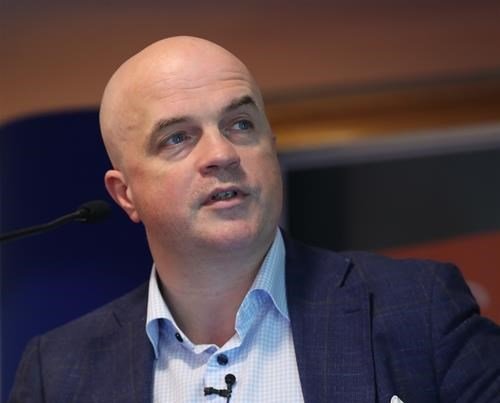The delays to the New Children’s Hospital have attracted national attention. David Lynch investigates if these delays will have an impact on other much-needed healthcare infrastructure and how the Covid-19 pandemic will affect capital development
The scale and rapid spread of the Covid-19 pandemic over the last year has meant the focus in health has often been on the short-term. Whether it was the scramble to provide sufficient personal protective equipment (PPE) to healthcare workers, the creation of a contact tracing system, or the rapid reconfiguration of emergency departments to deal with Covid-19, the health system has understandably been consumed by immediate priorities.
Therefore, it may be easy to conclude that medium-term planning and capital spending plans have slipped from the to-do list. This is not necessarily true. The largest health building project in the history of the State continues, however haltingly, with the construction of the New Children’s Hospital (NCH). In addition, ongoing plans for three new elective-only hospitals have recently been revealed, while a review of the National Development Plan 2018-2027 (NDP) is currently underway.
On top of this, all the medical representative bodies and many individual doctors have been vocal in arguing that deficiencies in capital infrastructure have made the pandemic response all the more difficult.
On this point the HSE officially agrees.
Risk
‘Capital infrastructure and critical equipment’ is one of the 26 risks included on the Executive’s most recent corporate risk register, dated October 2020 and approved by the HSE board at its meeting in December.
According to the document, seen by the Medical Independent (MI), risks associated with capital infrastructure are among the 17 red risks on the register (the other nine are amber).
“There is a risk to service continuity, access to and quality and safety of health services as a result of: Inadequate built infrastructure, ageing critical clinical equipment, including ambulances, failure to comply with regulatory requirements, eg, HIQA, Mental Health Commission, Health and Safety Authority, and building regulations,” according to the register.
The Executive notes an added infrastructural risk created by the pandemic with “additional requirements emerging from the Covid-19 response in terms of new service locations and physical distancing requirements in existing locations, the impact of Covid-19 on the nature of accommodation for residents of long-term residential care settings”.
In another red risk, the HSE makes particular mention of one very high-profile project. The document notes the “risk of adverse impact” on the provision of children’s health services, increased costs, and reputational damage to the Executive because of the delays and budget concerns over the NCH.
The NCH is the “most significant capital investment project ever undertaken in healthcare in Ireland”, according to the Children’s Health Ireland (CHI) website. Will the NCH’s timetable and budget difficulties have a knock-on effect on other major health projects? Some experts think it will.
Implications
The “scale of the cost over-run” of the NCH will “have implications for other capital projects in the area of health as well as other areas”, Dr Brian Turner (PhD), Department of Economics, Cork University Business School, University College Cork (UCC) told MI.

Dr Turner said the NDP made provision of €10.9 billion for health-related capital projects, including new hospitals, primary care centres, and residential care facilities, among others.
“Given the likely final cost of the NCH, as well as ongoing construction tender price inflation, this figure may well not be sufficient to provide all of the planned additional capacity,” he said.
Dr Turner noted that the tender price index from the Society of Chartered Surveyors Ireland increased by over 57 per cent between the low in 2011 and the second half of 2020, notwithstanding a slowdown in the rate of increase due to the Covid crisis. The NCH was due to be completed by the end of 2022 and handed over to CHI to open in 2023 after a period
of commissioning.
However, as the National Paediatric Hospital Development Board (NPHDB) Chief Officer David Gunning informed the Dáil Public Accounts Committee earlier this year, the project was delayed by 10 months.
“The project was behind schedule before Covid-19, primarily due to the construction site being consistently under-resourced by the main contractor, and that delay has been exacerbated by Covid-19,” a NPHDB spokesperson told MI.
This newspaper has been told that the NPHDB has conducted an analysis on the programme timeline and it is currently being considered by the Department of Health. In December MI reported that the CHI board also planned to carry out “in-depth analysis” of further possible delays to the construction of the hospital and its impact on health services for children.
However, the NPHDB spokesperson also struck an optimistic note, telling MI that despite the delays “the new children’s hospital building is taking shape”.
“Over 90 per cent of all concrete has been placed and the main contractor has advised that the concrete frame will be complete” by the end of March, according to the spokesperson.
“The NPHDB is aware of how badly needed the New Children’s Hospital is and of the impact that any further delay will have on the children, young people, and their families and staff that are waiting for it to open and on the residents who live close to the site. Everyone working on the project is focused on making the New Children’s Hospital a reality as soon as possible.”
Beds
Beyond the stuttering progress of the NCH, wider challenges with bed capacity and other shortfalls in health infrastructure have long been raised by the medical representative bodies.
The pandemic has only “further exacerbated existing problems in our health system”, Prof Alan Irvine, IHCA President and Consultant Dermatologist at CHI at Crumlin, told MI.

He said these problems were “the severe deficits” in both operational and capital investment in our acute hospitals.
“We do not have a sufficient number of consultants, beds, and other frontline facilities and resources to meet the demands of our nation’s patients,” said Prof Irvine.
“Without delay, the Government must prioritise the opening of acute hospital beds and recruit the consultants needed to treat over 800,000 patients currently on waiting lists.”
Prof Irvine said the experience of the pandemic and longer trends in demographic changes in the population, mean the Association is “strongly recommending” that Ireland’s acute hospital capacity be expanded, by a minimum of 6,000 additional acute beds.
He said that such expansion should be included as part of the revision of the NDP. The current NDP calls for an increase of just 2,600 acute beds.
“This includes the need to significantly expand the availability of single occupancy rooms and to rapidly expand and develop collocated protected elective-only surgery facilities across our hospitals,” said Prof Irvine.
The NDP promises the building of three new dedicated elective-only hospitals. Will this improve capacity issues in the acute sector? As reported in the last issue of MI (25 February), the elective hospitals oversight group (EHOG) has prepared a preliminary business case for the three hospitals in Dublin, Cork, and Galway.
Speaking during the annual conference of the National Clinical Programme in Surgery (NCPS), hosted by the RCSI online, EHOG member Mr Kenneth Mealy, immediate past-President of the RCSI and NCPS joint Clinical Lead, said that these new hospitals would alleviate pressure in the current hospital system. However, he noted that this would most likely be in relation to waiting lists, theatre space, and some other areas, but not necessarily bed capacity.
Growth
The IHCA President told MI the new NDP must provide an expansion of ICU capacity in line with the 2009 HSE-commissioned Prospectus report, which recommended 579 beds by 2020.
“Population growth not catered for in the 2009 report increases the requirement further. Our ICU beds normally operate at almost full capacity, which is unsafe, as the recommended occupancy rate for ICU should be 75 per cent or less,” said Prof Irvine. But what will be the impact of the pandemic, if any, on the future of capital spending in health?
“The significant additional allocation of funding in Budget 2021, announced in October 2020, includes provision of funding to allow the HSE to open an additional 1,146 inpatient beds and 66 critical care beds by the end of 2021, compared with the start of 2020,” Dr Turner told MI. Although the health economist added that it was “unclear” how many of these will be in new facilities.
“However, there does appear to be a commitment to using the current circumstances as an opportunity to permanently increase capacity in our health services, both in terms of facilities and staffing, which is very welcome.”
Immediate
Obviously, building takes time. So what can be done in the more immediate future?
“We need to fill the 700 vacant permanent hospital consultant posts, as a matter of urgency,” said Prof Irvine
“And provide the necessary hospital beds and other capacities, if we are to reduce current record waiting lists and deal with the backlog resulting from pandemic and the postponement of non-Covid hospital care.
“Minister [for Health Stephen] Donnelly and the Department of Health have committed to expanding elective capacity in our hospitals with a view to alleviating bed capacity issues elsewhere and reducing waiting lists.
“There has been a serious failure to expand our acute hospital capacity over the past decade, which must be addressed without delay. The consequence is that waiting lists have significantly deteriorated and we are now paying the price on the double during the pandemic.”
Designing a pandemic response
The current pandemic has touched every aspect of the health system, including how we plan building our hospitals. Speaking last month at the RCSI hosted annual conference of the National Clinical Programme in Surgery, Ms Laura Magahy, Executive Director, Sláintecare, outlined progress in the development of the planned three new dedicated ambulatory, elective-only hospital facilities.
Asked by the Medical Independent (MI) how these plans have been affected by Covid-19, she noted the general “impact on elective care” due to cancellations during the pandemic.
“In terms of developing the ambulatory, elective centres [the pandemic] clearly impacted our thoughts around design,” she said.
Ms Magahy noted the current need for as much work to be done “remotely in advance” of a patient arriving at the new centre.
She also referred to issues around follow-up care and “the importance of telemedicine and also the separation of patients from each other”.
“In a way all those lessons have been pulled into the thinking” regarding the design of these centres, Ms Magahy said A National Paediatric Hospital Development Board (NPHDB) spokesperson told MI that “from the beginning” infection prevention and control was central to the design planning process of the NCH.
The spokesperson said the fact the “design process coincided with the Ebola epidemic” reinforced the importance of careful forward planning.
“There was always an awareness of the risk of future unknown epidemics and pandemics and this permeated design planning from the start.”
In the new hospital, rooms in the medical and surgical wards, the emergency department (ED), and the paediatric intensive care unit are single rooms. All patient rooms in the two urgent care centres are single rooms. Other infection control measures include isolation rooms and medical and surgical wards and double entry streams into the ED, which will allow for continued, non-infection related, health service delivery during a future epidemic or pandemic.
“Consideration was also given to the risk of aerosol and airborne contamination,” said the spokesperson. “As a result, the principles of isolation and provision of single rooms with specialised ventilation to ensure clean air has been considered in the design. There will also be ready access to courtyards and gardens for patients and staff.”
However, the current pandemic has had a direct impact on design. The spokesperson agreed that “there will…be lessons learnt from the Covid-19 pandemic, which will inform work practices and behaviour” into the future.
“The response to infection prevention and control involves practice and behaviours as well as building design.
“Undoubtedly, there will be new emerging infectious diseases; however, in following the above principles, Children’s Health Ireland will be in a position to respond to these infections and provide a safe environment for patients, their families, and staff.”
So what’s the plan?
The final review of the National Development Plan 2018-2023 is expected to be completed in the summer of 2021. The healthcare projects in the NDP are outlined on pages 88 and 89 of the plan.
These include the New Children’s Hospital, two outpatient departments and urgent care centres at Connolly Hospital, Blanchardstown and at Tallaght University Hospital. It also lists National Maternity Strategy developments including the replacement of standalone maternity hospitals by relocating the National Maternity Hospital to St Vincent’s, the Coombe Hospital to St James’s, the Rotunda Hospital to Connolly, and Limerick University Maternity Hospital at University Hospital Limerick.
National Cancer Strategy capital developments include the National Programme for Radiation Oncology at Cork, Galway, and Dublin, and the expansion of the BreastCheck screening programme. The development of the National Forensic Mental Health Service Hospital at Portrane, Dublin, is also referenced in the plan.
Primary care centre construction programme across the country and the replacement and refurbishment of 90 community nursing units are outlined. In addition, the NDP cites 2,600 additional acute hospital beds to be delivered across all Hospital Groups. The Medical Independent asked for an update on these projects from the Department, but no response was received by press time.












Leave a Reply
You must be logged in to post a comment.